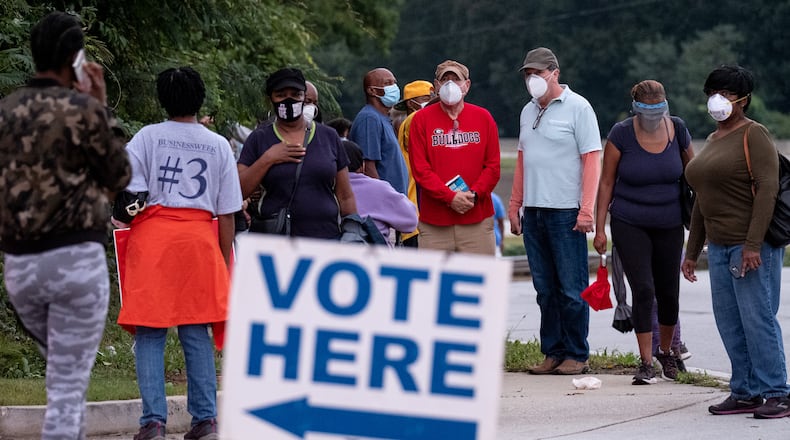Georgians returned to vote in the double senate runoff elections in unprecedented numbers, but DeKalb County voters bested them all.
The densely populated, mostly Democratic county had the lowest dropoff in voter participation between the general election and the runoffs of any county in metro Atlanta.
If that high turnout is repeatable, political leaders on both sides of the aisle believe DeKalb voters could be a major deciding factor in statewide races. Democrats hope DeKalb can solidify Georgia’s newfound status as the Deep South’s lone blue state, while Republicans worry that DeKalb’s block of blue votes may be too much to overcome.
“If nothing changes, DeKalb will continue to solidify blue (victories),” DeKalb Republican Party Chairman Lane Flynn said.
When compared to November’s presidential election, DeKalb’s total number of votes dropped 5% in the David Perdue/Jon Ossoff runoff and 4.8% in the Kelly Loeffler/Raphael Warnock runoff, according to Georgia Secretary of State data analyzed by The Atlanta Journal-Constitution. Democrats — Ossoff and Warnock — defeated Republican incumbents by a close margin to give their party control of the U.S. Senate.
Fulton County’s vote dropped about 6% in both races, and the dropoff was closer to 10% in Cobb and Gwinnett counties, both suburban areas which have voted more for Democrats in recent years.
On Jan. 5, rural counties were among the first to finish tallying their votes, which led to early leads for the two Republican candidates. However, DeKalb’s deluge of votes, about 84% of which went to Democrats, was the moment when the races flipped.
“The whole nation saw on Jan. 5 that DeKalb County is very-much a Democratic bastion,” DeKalb Democrats Chairman John Jackson said. “I do believe we’re the blue wall.”
Jackson credited years of grassroots campaigning and structure for the high turnout. He said the organizational backbone — led by former gubernatorial candidate Stacey Abrams — was a primary factor in why DeKalb led Georgia’s blue shift. It didn’t hurt that Abrams, who graduated from Avondale High School, represented state House District 89 in southwest DeKalb for years.
Flynn said Abrams’ recent efforts, which include the founding of voting rights groups like Fair Fight, mirror organizational gains that Republicans underwent in the 1990s, when the state’s politics were mostly controlled by Blue Dog Democrats. He said Republicans need to rebuild that effort, starting this year.
“We absolutely aim to sort of replicate what Stacey Abrams has done, because she sort of replicated what the GOP did in the ’90s,” he said. “I guess we got a little complacent and rested on our laurels a little bit. I know we do not have the level of organization that we should or that we did, and we’re working very hard to rebuild that.”
Nearly 8% of the votes cast in the runoffs were from DeKalb residents, and 10 metro Atlanta counties comprise almost half of the state’s electorate. Almost 350,000 DeKalb residents voted in the runoff compared to about 367,000 votes in the general election.
Flynn said Republicans have relied on high rural turnout for decades to solidify statewide wins, but he said gains need be made in metro Atlanta to stay competitive long-term.
“Don’t ignore DeKalb, ignore the cities or think you can only turn out the votes from rural areas, because that’s a numbers game you are eventually going to lose,” the Republican said.
DeKalb Democrats split their grassroots efforts between its 16 state House districts, forming committees to knock on doors, mail flyers and text voters. In addition, DeKalb had 13 early voting locations and more than 30 absentee ballot drop boxes. A Fair Fight spokesman said other metro counties could see similar turnout results if voting access is expanded to match DeKalb.
“In Cobb, half of early voting locations were eliminated for the runoff. In Gwinnett, you have a board chair who wants to eliminate early voting entirely,” the spokesman said in an emailed statement that referenced Alice O’Lenick’s comments about changing election laws so Republicans “at least have a shot at winning.”
South DeKalb, which is majority Black and Democratic, turned out at the highest rate in the county. The dropoff for Ossoff in DeKalb’s Commissioner District 3, which includes much of House District 89, southeast Atlanta and southwest DeKalb, was less than 2%.
Rep. Bee Nguyen, who now represents House District 89, said the organizational roots are developed enough at this point that she expects high turnout to be the norm in her region going forward.
“When voters are better equipped with information about — not just candidates — but the process as a whole, they’re going to continue to show up at the polls,” she said.
Warnock and Republican Gov. Brian Kemp will be up for reelection in 2022. It’ll be difficult for Democrats to hold onto their newly acquired Senate seat and flip the governor’s race if DeKalb can’t replicate its high turnout, Jackson said.
“This is how you change the face of Democracy,” he said. “You have to show up, and you have to show up continuously.”
About the Author
The Latest
Featured



